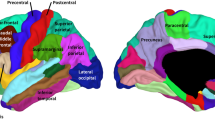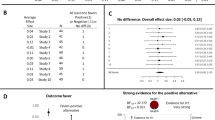Abstract
In this study, we investigated whether early deafness affects the typical pattern of hemispheric lateralization [i.e., right hemisphere (RH) dominance] in the control of spatial attention. To this aim, deaf signers, deaf non-signers, hearing signers, and hearing non-signers were required to bisect a series of centrally presented visual lines. The directional bisection bias was found to be significantly different between hearing and deaf participants, irrespective of sign language use. Hearing participants (both signers and non-signers) showed a consistent leftward bias, reflecting RH dominance. Conversely, we observed no evidence of a clear directional bias in deaf signers or non-signers (deaf participants overall showing a non-significant tendency to deviate rightward), suggesting that deafness may be associated to a more bilateral hemispheric engagement in visuospatial tasks.

Similar content being viewed by others
Notes
In Posner cueing paradigms, a cue is used to draw participants' attention to a location in space (usually to the left or to the right of the cue) where the target may appear (Posner 1980). Traditionally, the Posner task has been used to investigate attentional phenomena dependent on the location of the target relative to the cue. However, since stimuli usually appear either in the left or right visual field, the task has also been employed to measure hemispheric imbalance.
References
Bashinski HS, Bacharach VR (1980) Enhancement of perceptual sensitivity as the result of selectively attending to spatial locations. Percept Psychophys 28(3):241–248
Bavelier D, Brozinsky C, Tomann A, Mitchell T, Neville H, Liu G (2001) Impact of early deafness and early exposure to sign language on the cerebral organization for motion processing. J Neurosci 21:8931–8942
Bavelier D, Dye MWG, Hauser PC (2006) Do deaf individuals see better? Trends Cogn Sci 10:512–518
Bosworth RG, Dobkins KR (1999) Left-hemispere dominance for motion processing in deaf signers. Psychol Sci 10:256–262
Bosworth RG, Dobkins KR (2002) Visual field asymmetries for motion processing in deaf and hearing signers. Brain Cogn 49:170–181
Bosworth RG, Petrich JA, Dobkins KR (2013) Effects of attention and laterality on motion and orientation discrimination in deaf signers. Brain Cogn 82:117–126
Brentari D (2012) Phonology. In: Pfau R, Steinbach M, Woll B (eds) Sign language, and international handbook. Mouton de Gruyter, Berlin, pp 21–54
Brooks JL, Della Sala S, Darling S (2014) Representational pseudoneglect: a review. Neuropsychol Rev [Epub ahead of print]. http://www.ncbi.nlm.nih.gov/pubmed/24414221
Brozinsky CJ, Bavelier D (2004) Motion velocity thresholds in deaf signers: changes in lateralization but not in overall sensitivity. Brain Res Cogn Brain Res 21:1–10
Cai Q, Van der Haegen L, Brysbaert M (2013) Complementary hemispheric specialization for language production and visuospatial attention. Proc Natl Acad Sci 110(4):E322–E330
Cattaneo Z, Fantino M, Tinti C, Pascual-Leone A, Silvanto J, Vecchi T (2011) Spatial biases in peripersonal space in sighted and blind individuals revealed by a haptic line bisection paradigm. J Exp Psychol Hum Percept Perform 37:1110–1121
Cattaneo Z, Fantino M, Mancini F, Mattioli F, Vallar G (2012) Listening to numbers affects visual and haptic bisection in healthy individuals and neglect patients. Neuropsychologia 50:913–925
Cattani A, Clibbens J (2005) Atypical lateralization of memory for location: effects of deafness and sign language use. Brain Cogn 58:226–239
Cattani A, Clibbens J, Perfect TJ (2007) Visual memory for shapes in deaf signers and nonsigners and in hearing signers and nonsigners: atypical lateralization and enhancement. Neuropsychology 21:114–121
Chilosi AM, Comparini A, Cristofani P, Turi M, Berrettini S, Forli F, Orlandi G, Chiti A, Giannini N, Cipriani P, Cioni G (2014) Cerebral lateralization for language in deaf children with cochlear implantation. Brain Lang 129:1–6
Corina DP, Spotswood N (2012) Neurolinguistics. In: Pfau R, Steinbach M, Woll B (eds) Sign language, and international handbook. Mouton de Gruyter, Berlin, pp 739–762
Dolcos F, Rice HJ, Cabeza R (2002) Hemispheric asymmetry and aging: right hemisphere decline or asymmetry reduction. Neurosci Biobehav Rev 26:819–825
Emmorey K, Kosslyn SM (1996) Enhanced image generation abilities in deaf signers: a right hemisphere effect. Brain Cogn 32:28–44
Emmorey K, Damasio H, McCullough S, Grabowski T, Ponto LL, Hichwa RD, Bellugi U (2002) Neural systems underlying spatial language in American sign language. Neuroimage 17:812–824
Hillger LA, Koenig O (1991) Separable mechanisms in face processing: evidence from hemispheric specialization. J Cogn Neurosci 3(1):42–58
Jewell G, McCourt ME (2000) Pseudoneglect: a review and meta-analysis of performance factors in line bisection tasks. Neuropsychologia 38:93–110
Kinsbourne M (1974) Mechanisms of hemispheric interaction in man. In: Kinsbourne M, Smith WL (eds) Hemisphere disconnection and cerebral function. Thomas, Springfield, IL, pp 260–285
Kosslyn SM (1987) Seeing and imagining in the cerebral hemispheres: a computational approach. Psychol Rev 94:148–175
Lee HY, Wang YS (2011) Visual processing of music notation: a study of event-related potentials. Percept Mot Skills 112:525–535
Maril S, Hermesh H, Gross-Isseroff R, Tomer R (2007) Spatial attention and neural asymmetry in obsessive-compulsive disorder. Psychiatry Res 153(2):189–193
Mayberry RI, Chen J-K, Witcher P, Klein D (2011) Age of acquisition effects on the functional organization of language in the adult brain. Brain Lang 119:16–29
McCullough S, Emmorey K, Sereno M (2005) Neural organization for recognition of grammatical and emotional facial expressions in deaf ASL signers and hearing nonsigners. Brain Res Cogn Brain Res 22(2):193–203
Neville HJ, Lawson D (1987a) Attention to central and peripheral visual space in a movement detection task: an event-related potential and behavioral study. II. Congenitally deaf adults. Brain Res 405(2):268–283
Neville HJ, Lawson D (1987b) Attention to central and peripheral visual space in a movement detection task. III. Separate effects of auditory deprivation and acquisition of a visual language. Brain Res 405(2):284–294
Oldfield RC (1971) The assessment and analysis of handedness: the Edinburgh Inventory. Neuropsychologia 9:97–113
Padden CA (1988) Interaction of morphology and syntax in American sign language. Outstanding dissertations in linguistics, series 4. Garland, New York
Parasnis I, Samar VJ (1985) Parafoveal attention in congenitally deaf and hearing young adults. Brain Cogn 4(3):313–327
Patston LM, Corballis MC, Hogg SL, Tippet LJ (2006) The neglect of musicians: line bisection reveals an opposite bias. Psychol Sci 17:1029
Pavani F, Bottari D (2012) Visual abilities in individuals with profound deafness: a critical review. In: Murray MM, Wallace MT (eds) The neural bases of multisensory processes. CRC Press, Boca Raton, pp 423–447
Posner MI (1980) Orienting of attention. QJEP 32:3–25
Proksch J, Bavelier D (2002) Changes in the spatial distribution of visual attention after early deafness. J Cogn Neurosci 14:1–5
Reynolds HN (1993) Effects of foveal stimulation on peripheral visual processing and laterality in deaf and hearing subjects. Am J Psychol 106:523–540
Schmitz R, Peigneux P (2011) Age-related changes in visual pseudoneglect. Brain Cogn 76:382–389
Weisberg J, Koo DS, Krain KL, Eden GF (2012) Cortical plasticity for visuospatial processing and object recognition in deaf and hearing signers. Neuroimage 60(1):661–672
Acknowledgments
We would like to thank Martina Gerosa, Carlo Geraci, and Stefano Zanoletti for their help in recruiting participants, and the ENS of Bergamo and Monza for their warm hospitality. We also thank Carlo Toneatto for technical support, Alice Rinaldi, Carlo Marchelli, and Matteo Tagliaferri for their precious help in data collection, and Susan Campbell for editing.
Author information
Authors and Affiliations
Corresponding author
Rights and permissions
About this article
Cite this article
Cattaneo, Z., Lega, C., Cecchetto, C. et al. Auditory deprivation affects biases of visuospatial attention as measured by line bisection. Exp Brain Res 232, 2767–2773 (2014). https://doi.org/10.1007/s00221-014-3960-7
Received:
Accepted:
Published:
Issue Date:
DOI: https://doi.org/10.1007/s00221-014-3960-7




